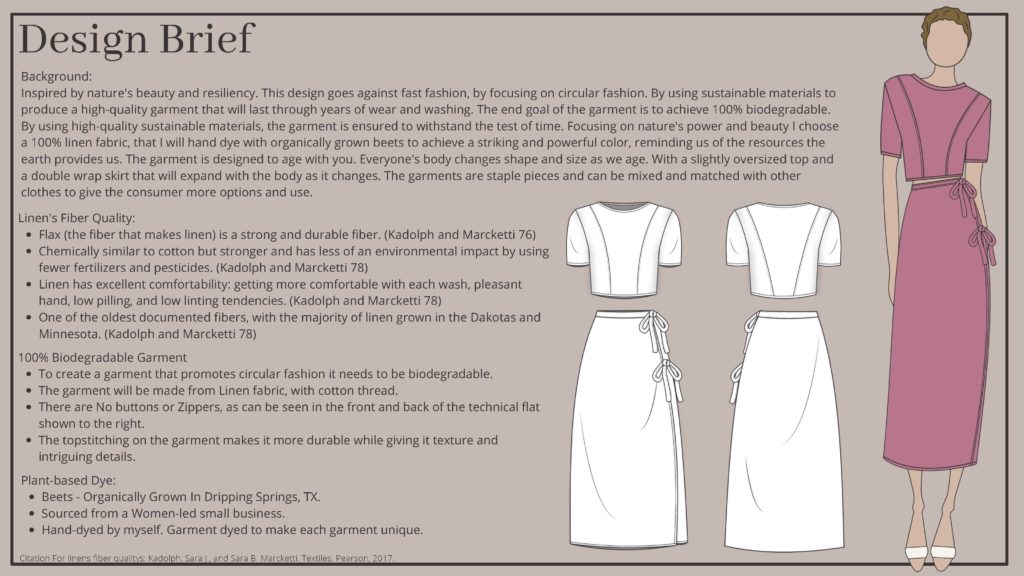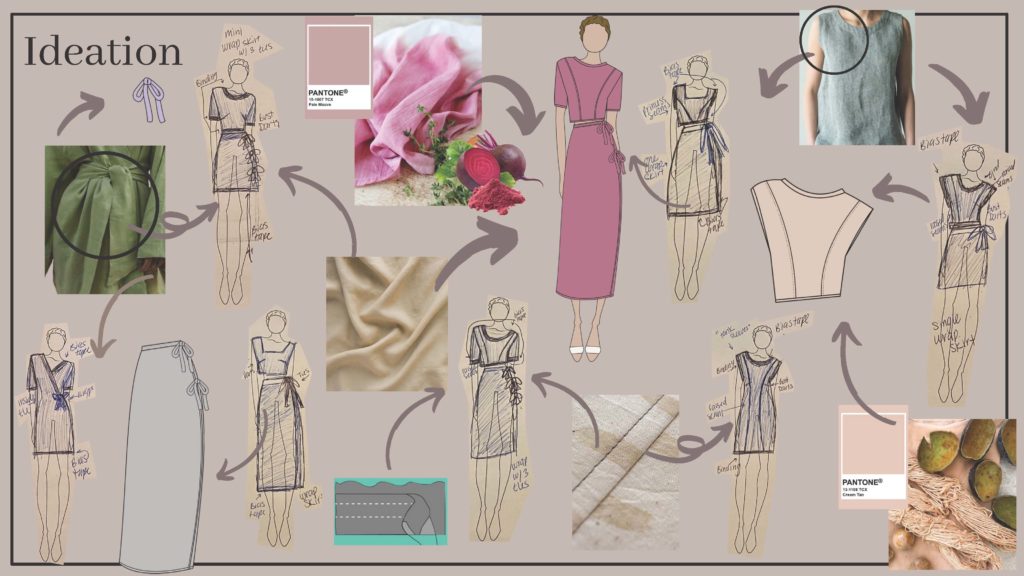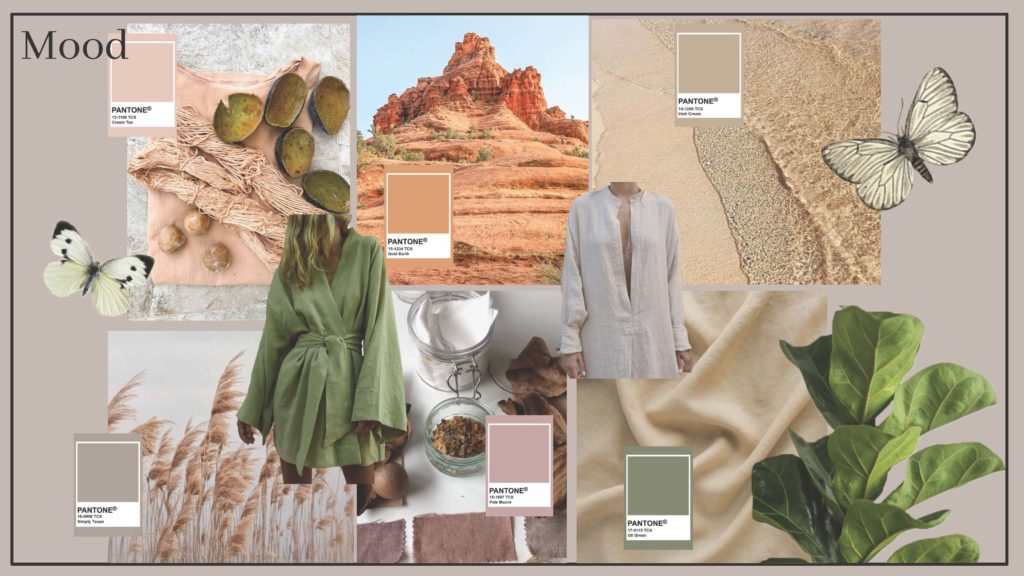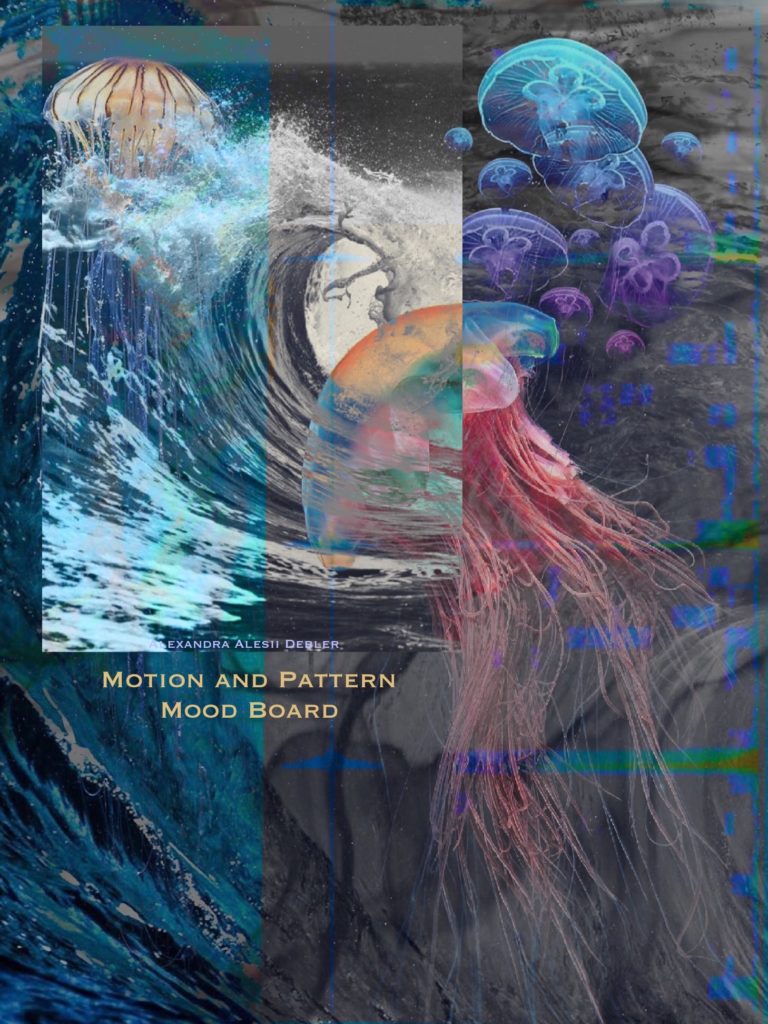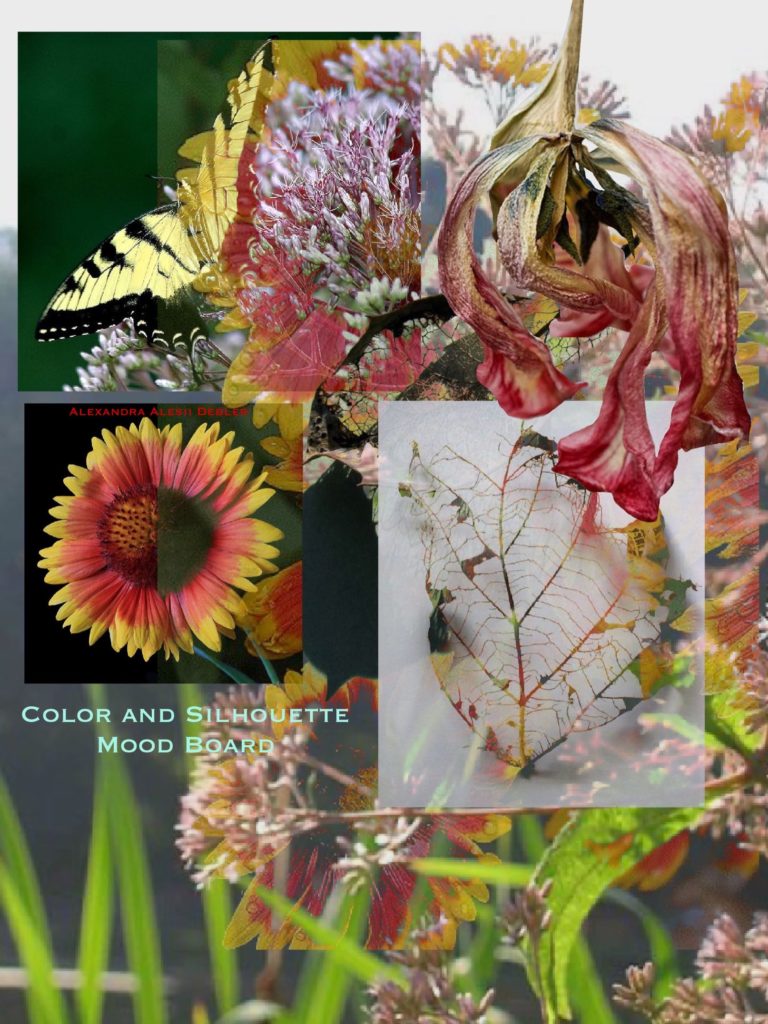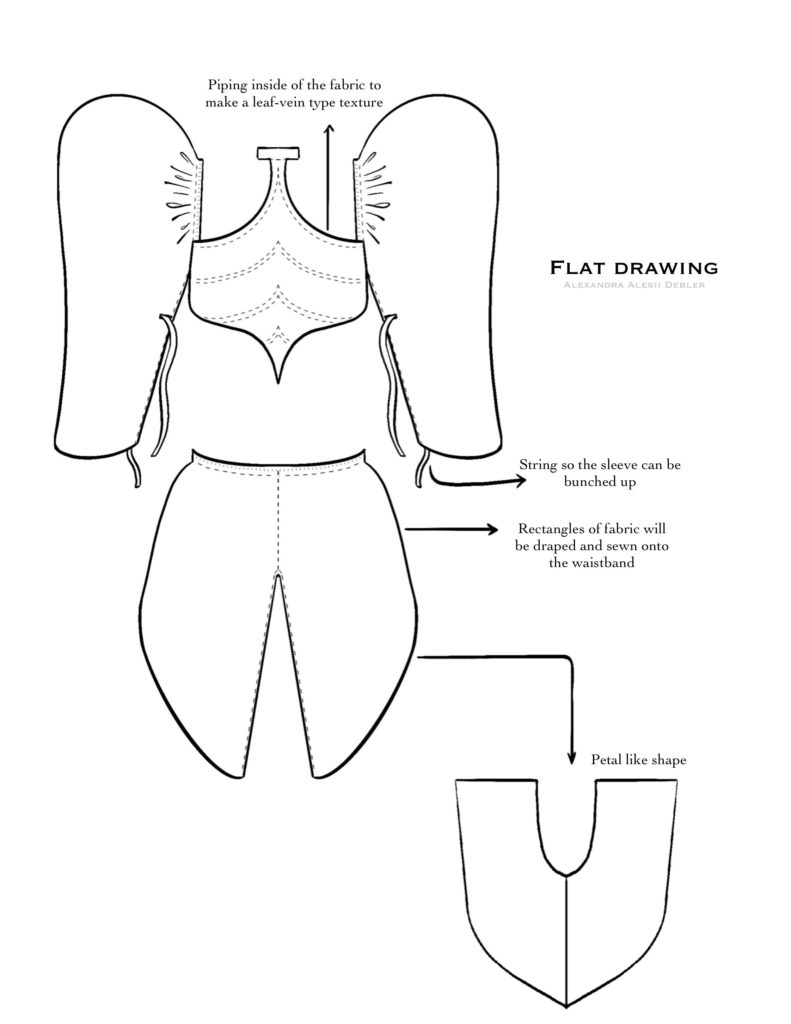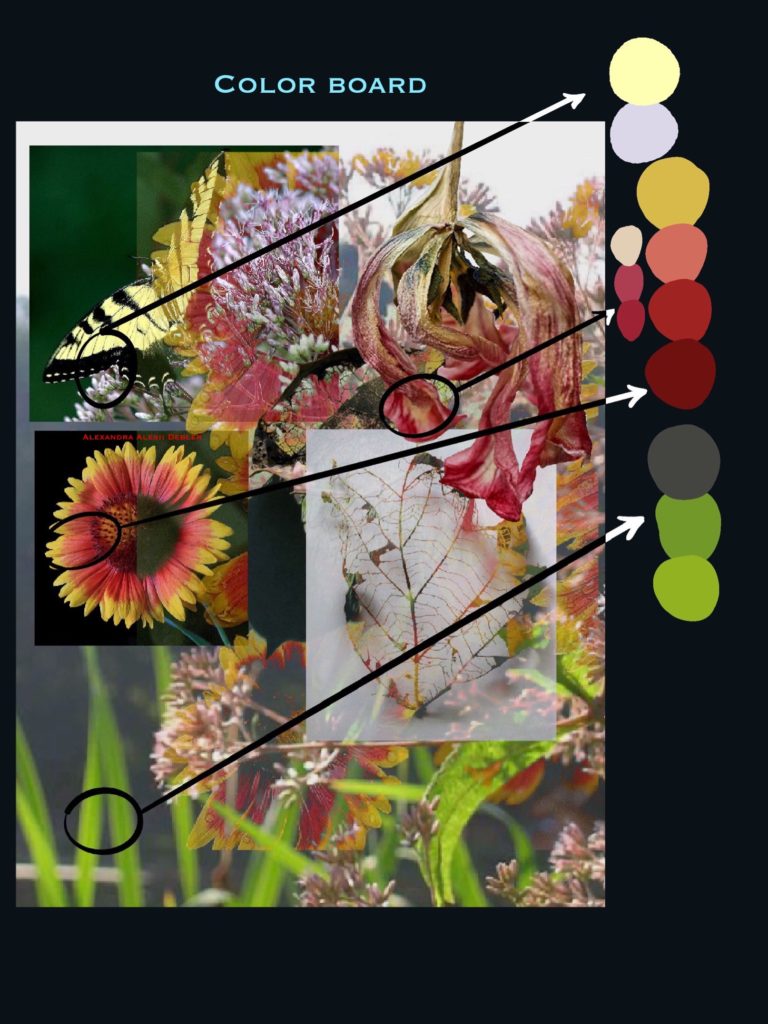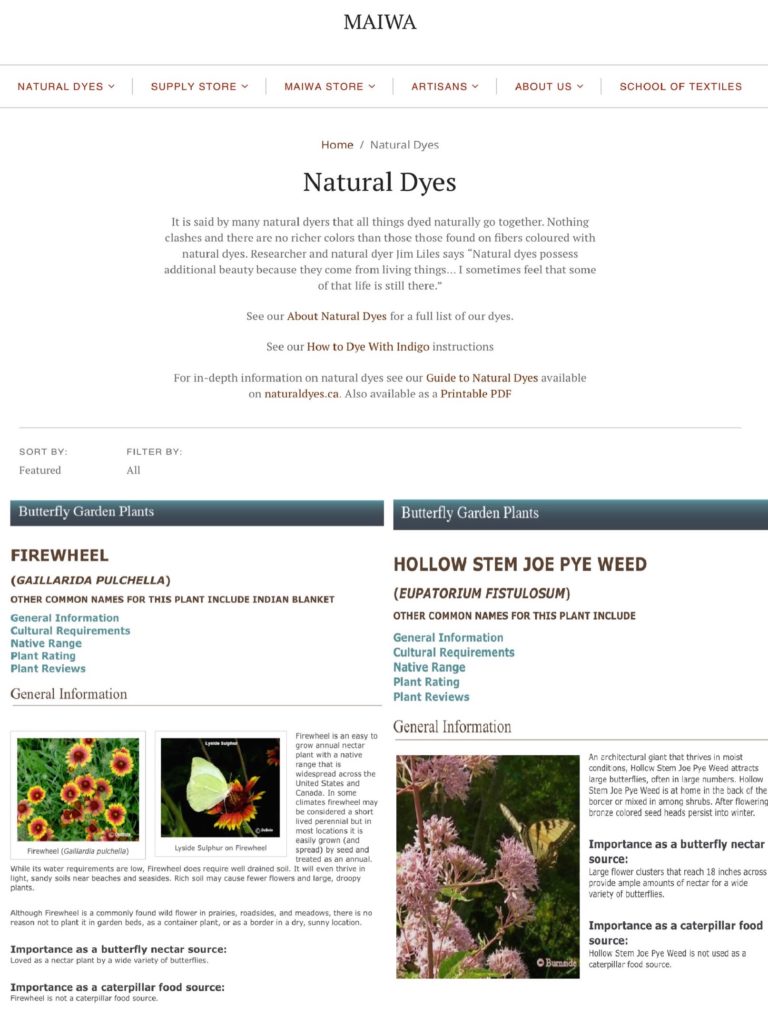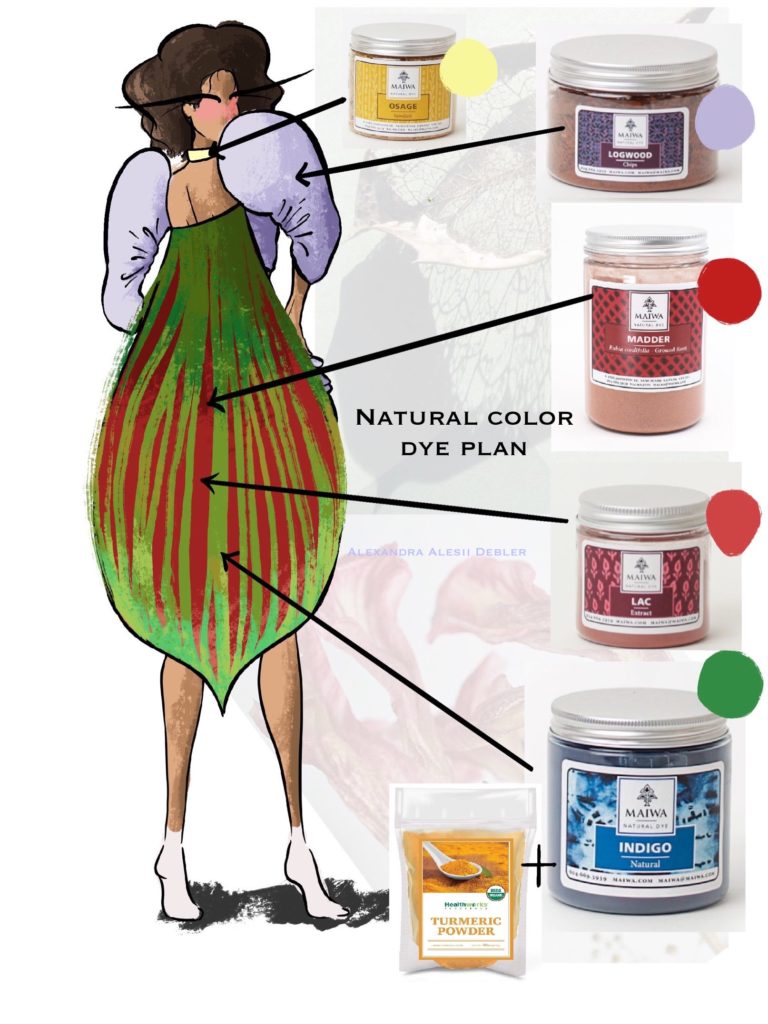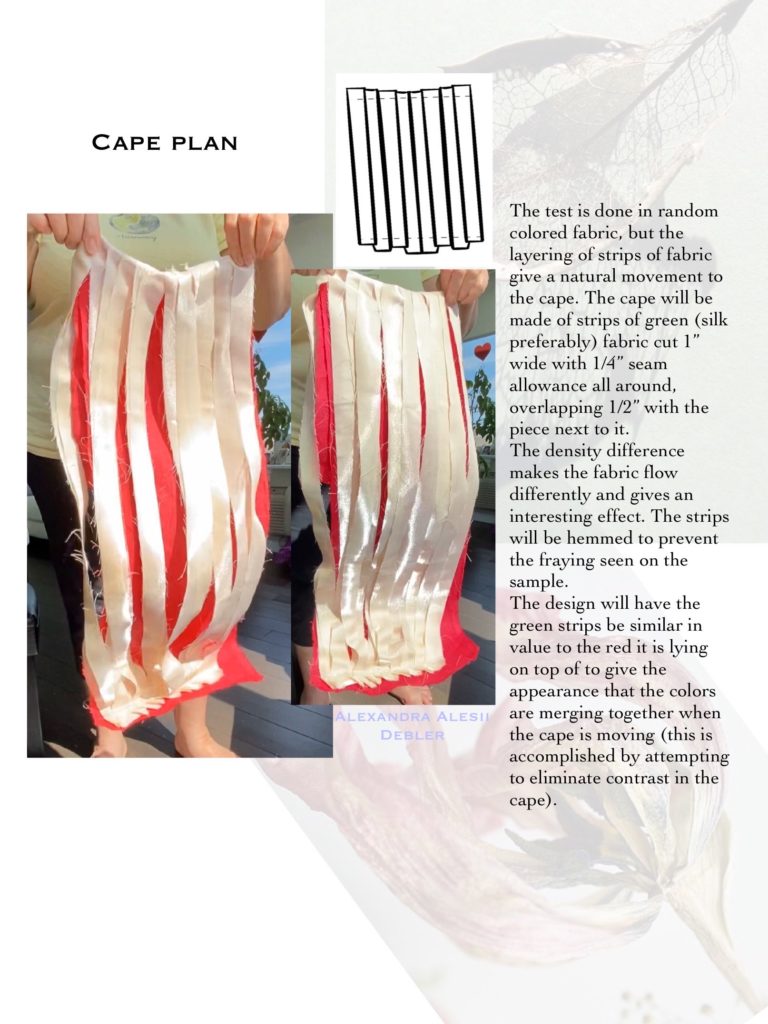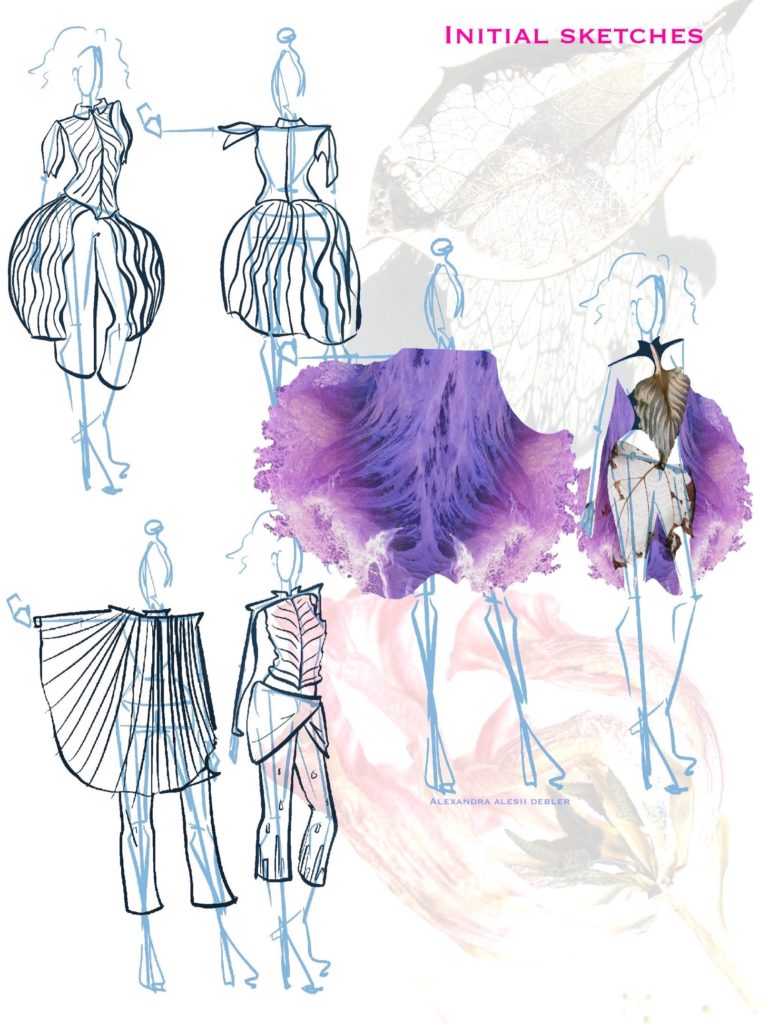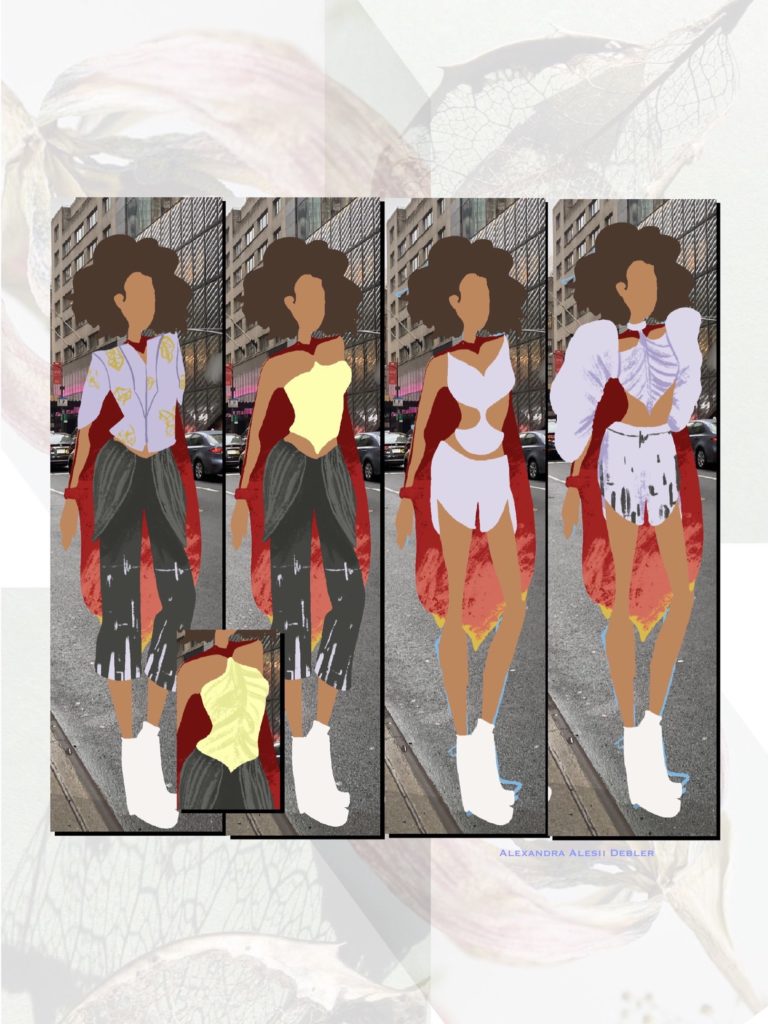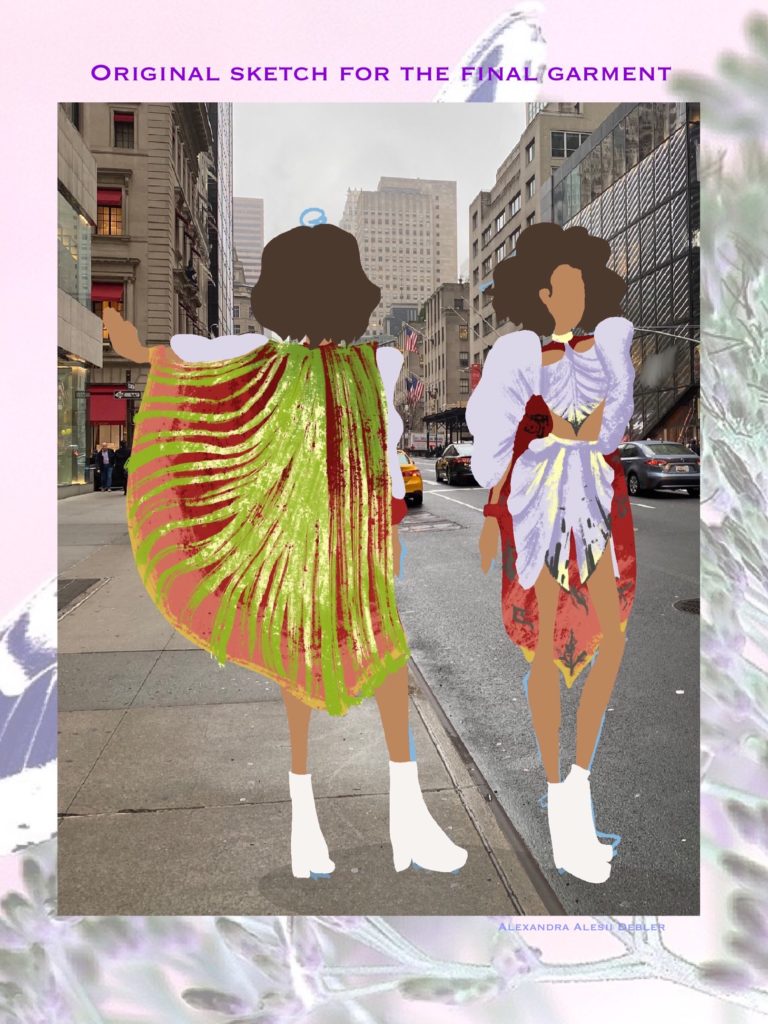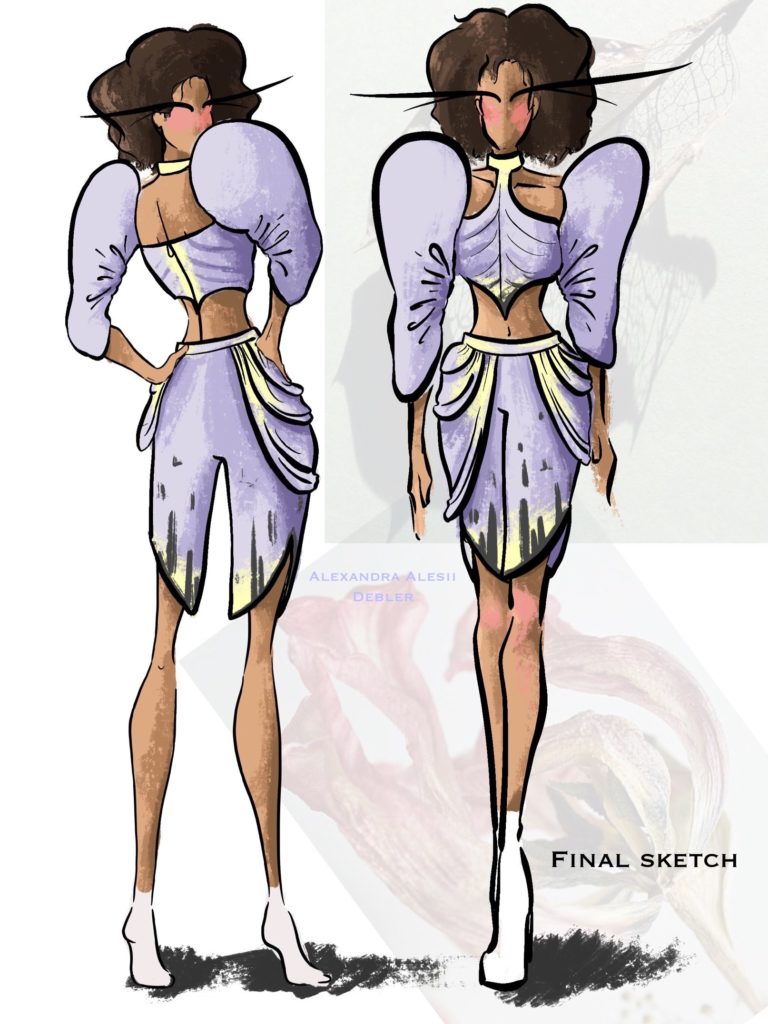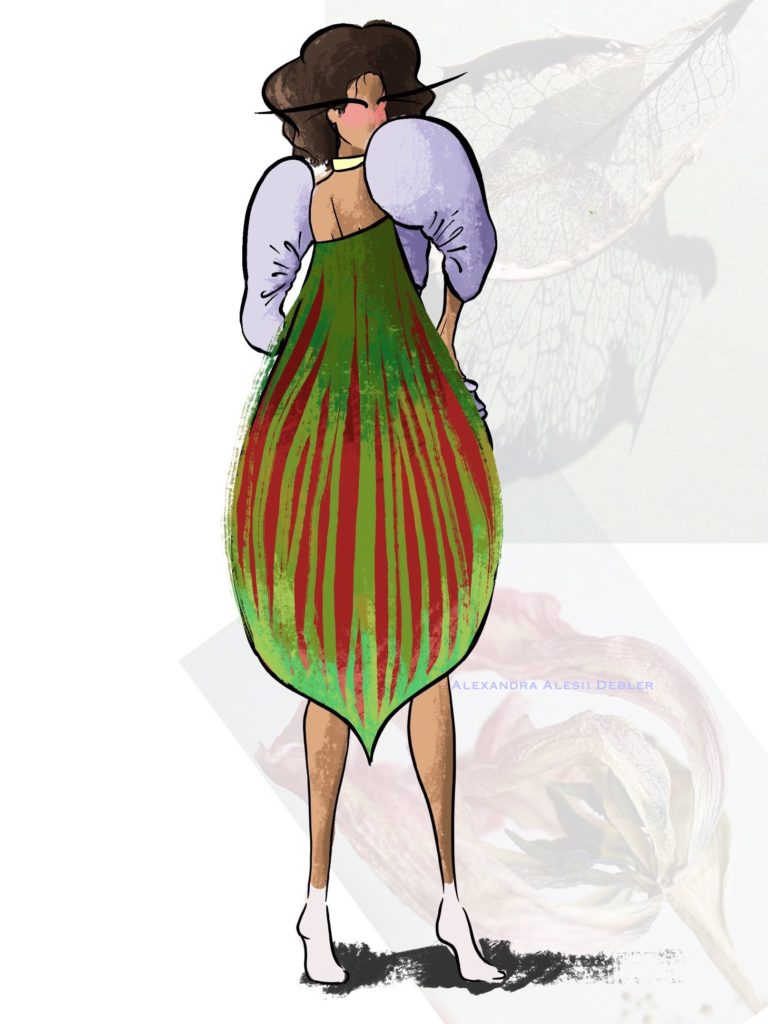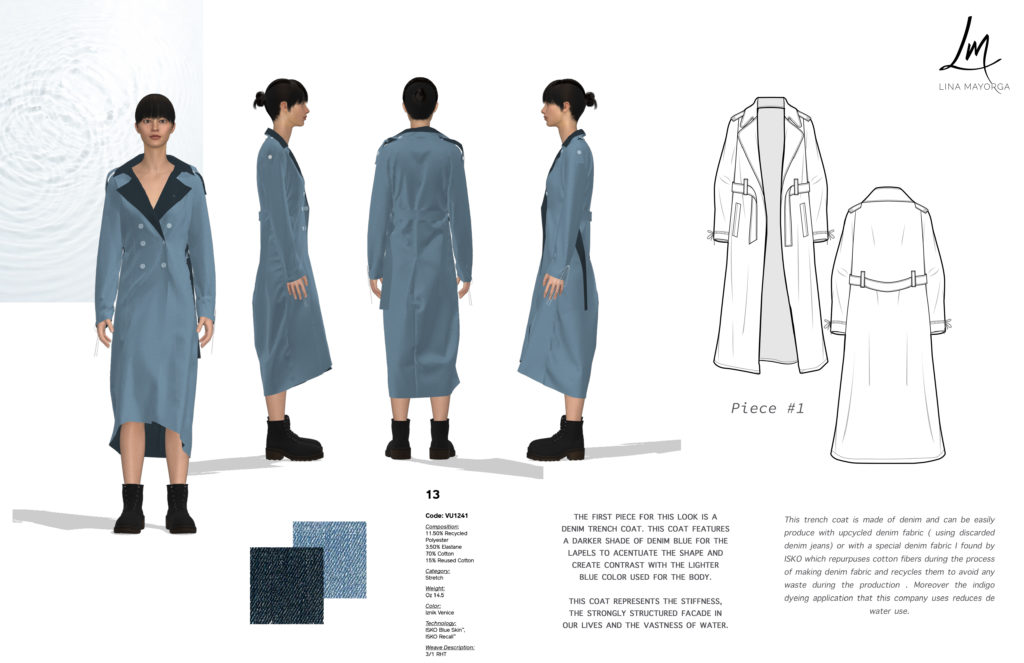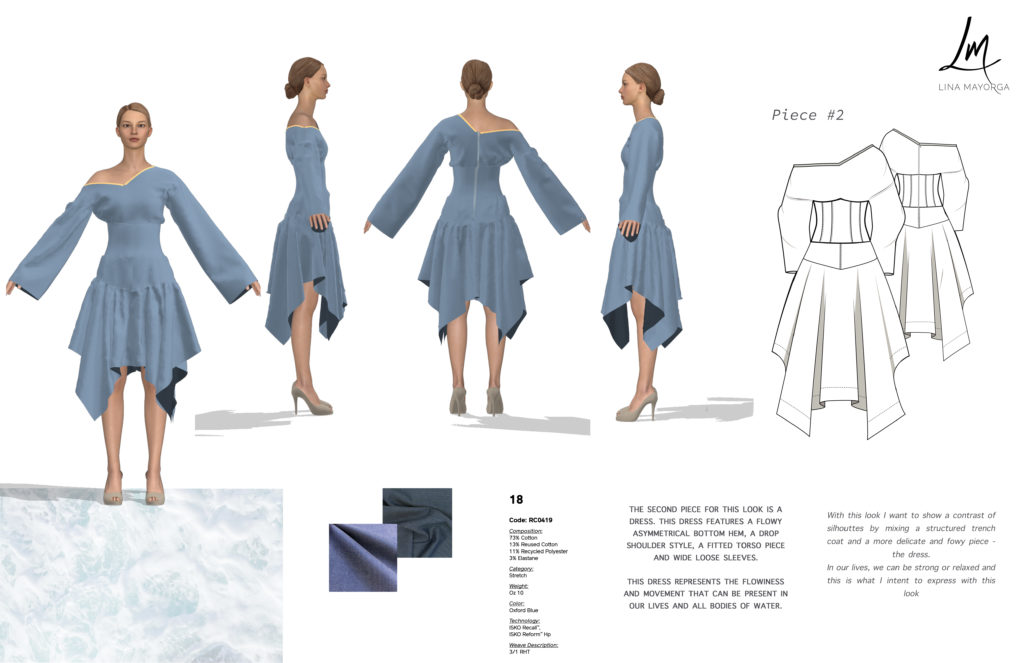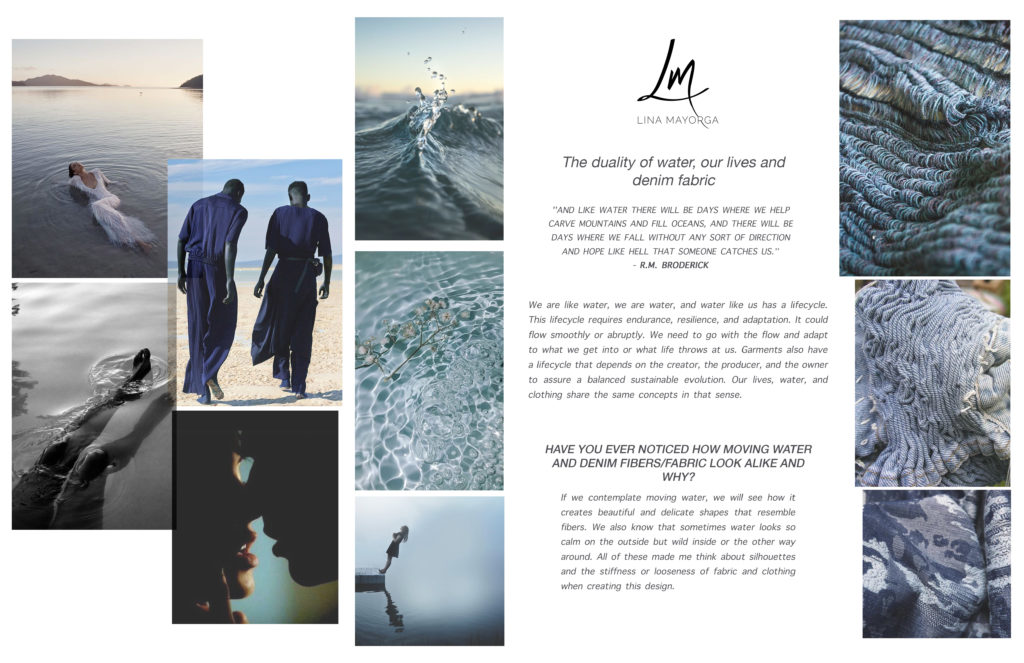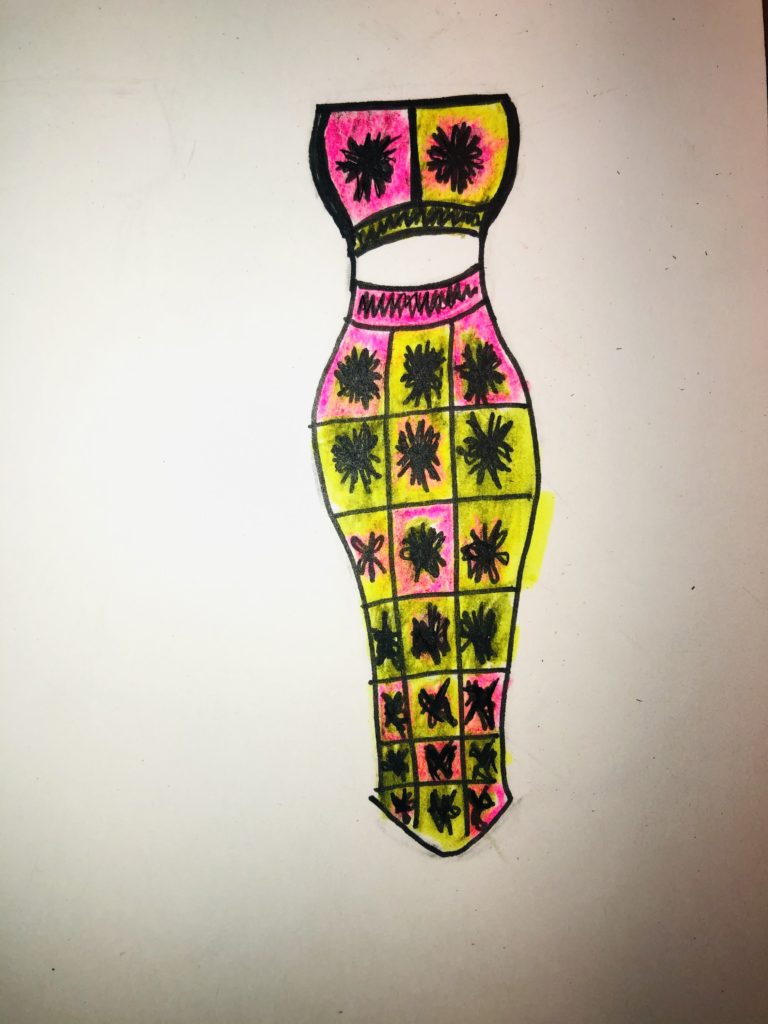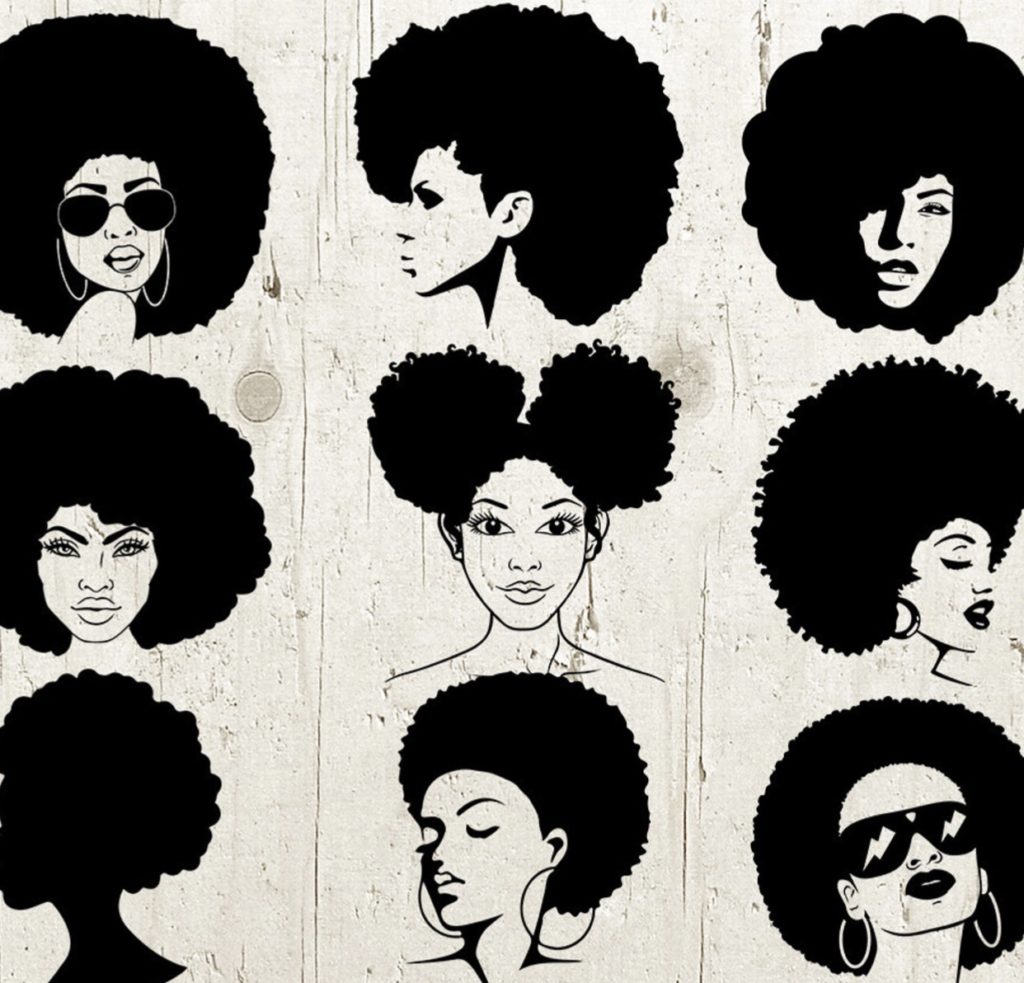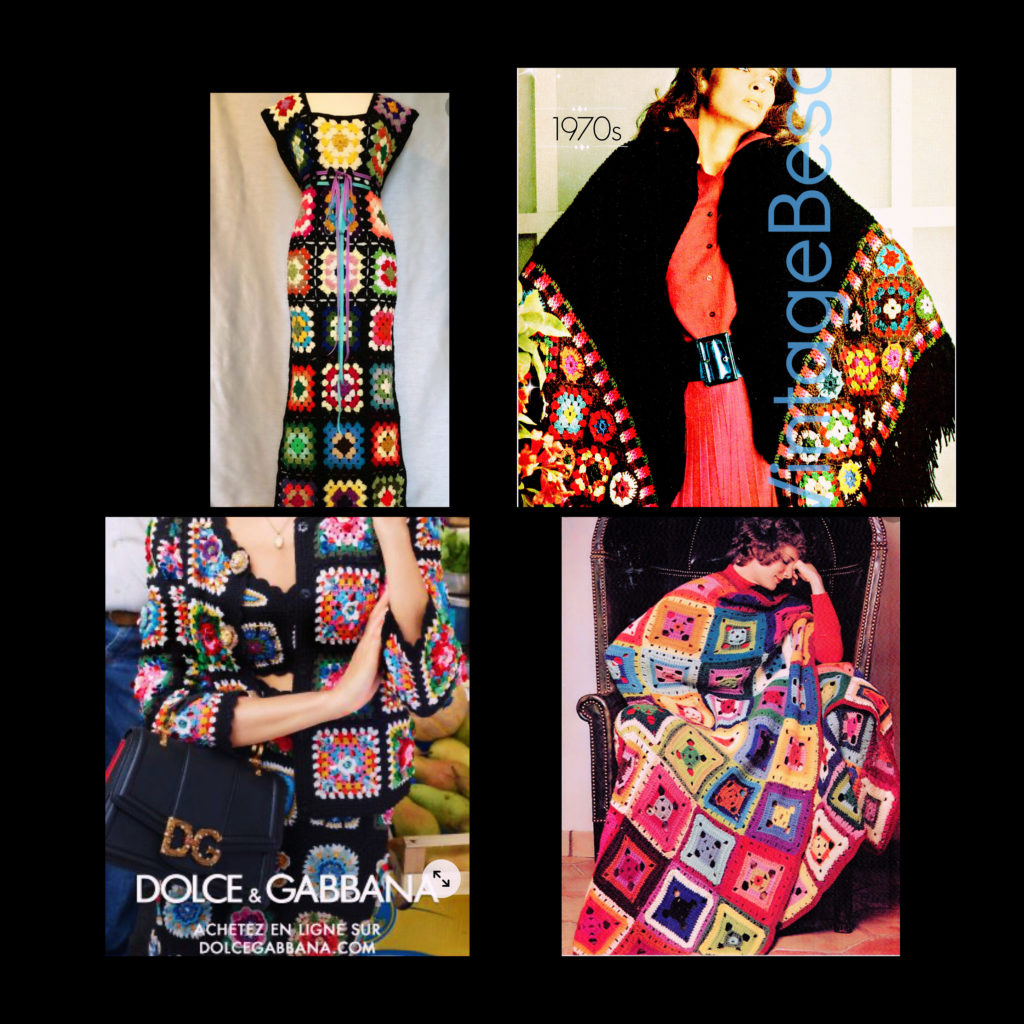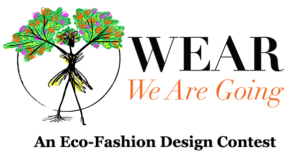
Contestant Dossiers
Please review all contestant dossiers before proceeding to contestant scoring. All dossiers appear below in alphabetical order by the contestants’ last names. Please only consider materials from these dossiers in the judging process; do not consider any other materials you may have seen regarding the Wear We Are Going contest or its contestants (for example, do not consider material in social media posts from the contest organizers or from the contest finalists).
Contestant #1
Morgan Davis
Personal Introduction
Hi, I’m Morgan. I’m a senior at the University of Texas studying for a bachelor’s in Textiles and apparel through the school of Natural Science. I’m a fabric, design, dog, and outdoors lover. I work as a TA for computer aid design apparel at UT. This summer I’m working for a small apparel business as an intern! I have a love for sustainable design and constantly looking to learn more.
Initial Design Concept
Inspired by nature’s beauty and resiliency. This design goes against fast fashion, by focusing on circular fashion. By using sustainable materials to produce high-quality garments that will last through years of wear and washing. The end goal of the garment is to achieve 100% biodegradable. By using high-quality sustainable materials, the garment is ensured to withstand the test of time. Focusing on nature’s power and beauty I choose a 100% linen fabric, that I will hand dye with organically grown beets to achieve a striking and powerful color, reminding us of the resources the earth provides us. The garment is designed to age with you. Everyone’s body changes shape and size as we age. With a slightly oversized top and a double wrap skirt that will expand with the body as it changes. The garments are staple pieces and can be mixed and matched with other clothes to give the consumer more options and use. To create a garment that promotes circular fashion it needs to be biodegradable. The garment will be made from Linen fabric, with cotton thread, there are No buttons or Zippers. The topstitching on the garment makes it more durable while giving it texture and intriguing details. The beets are locally sourced by a women-led small business. They are grown organically and will be used to hand dye the garment. The garment set is garment dyed to produce a unique color, resulting in less water needed in the dying process. The design is an original idea. I have sourced images for the project and have a citation page on request (as I already had 3 chosen files to upload and could not upload it as the 4th document). The citation for the information about linens’ sustainable quality is located on the design brief page as well as an in-text citation.
Initial Materials
Organically grown beets, 100% linen fabric, cotton thread, water for dying process, stainless steel pot (for dying the fabric)
Initial Design Sketches, Renderings, & Mood Boards
Final Design
Design Perspectives
Design Detail Closeups
Design in Motion
Any significant changes in the final design from the original proposal:
N/A
Any additional information submitted for consideration:
N/A
Contestant #2
Alexandra Debler
Personal Introduction
My name is Alexandra Alesii Debler; I am from New York City and an undergraduate at the Rhode Island School of Design. I’m an apparel student and designer, and I love all aspects of art including body painting, illustration, character design, and music. My practice as a designer is centered around sustainability and authenticity. Being a feminist and a part of the LGBTQ+ community, I strive to infuse my identity and experiences into the clothing I create. My goal is to inspire confidence, comfort, and a sense of fun for the wearer.
Initial Design Concept
The vision of this garment is to create a flower in the city; the embodiment of the resilience to be yourself surrounded by uniformity. The garment is in pattern and motion inspired by the nature of the ocean, and in color and silhouette inspired by the nature of the land. For example, I drew inspiration from the firewheel flower and hollow stem joe pye weed because these are plants native to New York. This inspiration can be seen in the two mood boards. The garment hopes to show that one can remain true to themselves while adapting to their surroundings. It will be photographed in Manhattan.
The grey pattern on the bottom of the shorts is derived from sound waves of marine life, and shows that adaptation (the grey of NYC) is an enhancement to your being, not a hindrance. Further inspiration of the city is the practicality of the outfit. It is a part of the piece that does not take away from it, but simply allows it to exist in the environment it was catered towards. Due to the upwards volume of the sleeves and detachable cape, the wearer can walk in a crowd, ride the subway, and perform other everyday activities with ease. The garment will juxtapose the architecture of New York City while maintaining the heart of its people and the designer.
In being sustainable, all textiles used to create the garment will be acquired from Fabscraps. Fabscraps, a local 501(c)3 charitable organization based in Brooklyn, collects textile waste and reuses/recycles it. The garment will be constructed out of cotton or sheepskin. The cape will be made out of silk, and then naturally dyed (see “rendering” and materials list for specifications). Because Fabscrap relies on donations, it has a large but inconsistent inventory. Based on availability, I may be able to acquire already-colored material, which would lower the cost of construction.
Initial Materials
All fabrics will be acquired from Fabscrap, which sells donated textiles and scraps for the purpose of sustainability. For the core of the outfit, I will need cotton or sheepskin for the top/pants (the yardage will depend on the width, since the pattern is composed of relatively small pieces). The cape will need 1 ½ yards of cotton fabric and 2 yards of silk or chiffon to make the strips that overlay it. This outfit was designed with the idea that undyed cotton and silk fabrics would be used, so I have listed the natural dyes below. All dyes will be bought from Maiwa unless otherwise specified. The fastenings of the cape to the outfit will be nickel-plated brass sew-on snaps, the neck-piece will be buttoned, and the back of the shirt will be zippered (12”). These components will all come from Fabscrap. The dyes (also see “rendering” for the board with area specification):
Yellow – Osage, 3.6oz for $10.95 or eucalyptus from the grocery store and/or hand picked.
Light Purple – Watered down Logwood chips, 3.6oz for $23.95
Darker Red – Madder, 8oz, $11.95
Lighter Red – Lac, 1.1oz, $14.95 (will probably need more)
Green – Indigo, 1.1oz, $8.95 mixed with the osage mentioned earlier or eucalyptus
Total cost (estimated from Fabscrap’s online store): Fabric (not fixed): Bamboo Jersey, 5 yards ($25); Or White Cotton, 3 yards ($30), or 1 ½ yards ($15); Or Sheepskin, 5ft ($25-30); Or 3 natural white fabric scrap packs (total $15); Tulle or Chiffon ($10). Fastenings: Buttons – $3; Zippers – $3; Sew on snaps – $0 (Already owned); Dyes: All Dyes (listed previously) – $70.75; Total: If dye is not needed and I volunteer* (only need to pay for the fastenings): $6; If dye is not needed at all (created with chiffon, cotton, and sheepskin): $61; If dye is needed for everything (cotton, sheepskin, dyes, chiffon, and fastenings): $116.75; Most likely (estimated with white and red cotton, logwood dye, fastenings and pre-colored chiffon): $59.95; *Note: There is also the potential that the fabric can be acquired for free. Fabscrap gives 5 pounds of fabric in exchange for a day of volunteering. This is a possibility if I am able to get to their warehouse in Brooklyn.
Initial Design Sketches, Renderings, & Mood Boards
Final Design
Design Perspectives
Design Detail Closeups
Design in Motion
Any significant changes in the final design from the original proposal:
I decided to paint the cape instead of layering fabric on it because the layers were making the outfit feel costumey instead of Avante Garde and artsy. The paint fits much better with the design on the pants and showcases another aspect of my art practice.
Any additional information submitted for consideration:
Hello! My model is an old friend of mine from High School – her name is Hannah Hwang. I did her makeup myself and I adore how it came out. I also included some of the photos I took of the outfit at the end of the close-up video so you can see a bit of my photoshoot style. I hope you enjoy the work and I thank you again for this amazing experience and opportunity!
Contestant #3
Lina Mayorga
Personal Introduction
Lina Mayorga is a sustainable vegan fashion designer and social media influencer who graduated from Parsons The New School of Design in Fashion Design. Born in Colombia and based in New York City. Her designs have been featured in Fashion TV, NY1 News, Univision, and Not Just a Label. Gained recognition of sustainable designing in 2017 as a finalist of the Redress Design Award in Hong Kong and won ISKO ISKOOL Best Denim Talent Look Award in 2020. Has participated as a speaker for FIT and PETA discussing ‘vegan fashion’ and at Neonyt Expo in Berlin about ‘reinventing denim and the global impact of her responsible choices’.
Initial Design Concept
Our most precious resource in the universe is water. We know this and we don’t acknowledge the beauty of this element and how everything is alive thanks to the existence of water.
This poem by R.M. Broderick resonated with me, the concept behind my look and with what I want to express for this submission; it says ”And like water there will be days where we help carve mountains and fill oceans, and there will be days where we fall without any sort of direction and hope like hell that someone catches us.”. We are like water, we are water, and water like us has a lifecycle. This lifecycle requires endurance, resilience, and adaptation. It could flow smoothly or abruptly. We need to go with the flow and adapt to what we get into or what life throws at us. Garments also have a lifecycle that depends on the creator, the producer, and the owner to assure a balanced sustainable evolution. Our lives, water, and clothing share the same concepts in that sense.
If we contemplate moving water, we will see how it creates beautiful and delicate shapes that resemble fibers. We also know that sometimes water looks so calm on the outside but wild inside or the other way around. All of these made me think about silhouettes and the stiffness or looseness of fabric and clothing when creating my design for this contest.
Cotton is known as a thirsty crop that requires tons of water to be grown and produced. I want to show the dichotomy of water and cotton with my look by using denim fabric. Denim cotton is known as a thirsty crop that requires tons of water to be grown and produced. I want to show the dichotomy of water, cotton, and our lives with my look by using upcycling and sustainable denim fabric.
I plan on using upcycled denim fabric or discarded denim pieces. I have done this in the past and it is a way to use the resources we already have instead of making new fabric from raw materials again, but I would prefer to use a denim fabric that caught my interest and not a lot of people know about. The fabric I intend on using is from ISKO and it has two types of special treatments that make denim more sustainable, one is called ISKO RECALL which helps with shape retention, and less water use in the garment cycle while adding a second-skin feel, and R-TWO which enables the producers to include reused fibers that are usually discarded when making denim to craft reused and recycled denim fabrics, while maintaining the durability and quality. These two special treatments on ISKO Denim fabric assure the creation of lasting impact at scale and the fabric is also available for small businesses and upcoming designers – It is hard for small businesses to get their hands on new fibers or materials, but this denim mill wants sustainable designers to make denim pieces more sustainable.
My look features two pieces, a trench coat which represents the stiffness and the strongly structured facade in our lives and the vastness of water, and a dress that represents the flowiness and movement that can be present as well in our lives and all bodies of water.
Initial Materials
Sustainable and upcycled denim fabric
Initial Design Sketches, Renderings, & Mood Boards
Final Design
Design Perspectives
Design Detail Closeups
Design in Motion
Any significant changes in the final design from the original proposal:
My initial trench coat design showed shades of light blue, but the special recycled denim fabric that I acquired which is made of discarded fibers, only comes in a dark blue shade. Since my main inspiration and concept was to show the dichotomy of water and denim(cotton), I didn’t want to use more water to lighten the fabric. Making denim lighter in small quantities is really expensive and it uses a lot of water. My solution was to use the backside of the fabric which is usually lighter than the right side, keeping the idea of having a coat with a light blue body and dark blue details or accents. The weave of the denim fabric is the same on both sides and I liked how it looks because both sides have the same hue.
Any additional information submitted for consideration:
In the process of moving from one state to another and later to another one with my family, I was able to finish my look and I feel proud of myself for that. My submission looks exactly like my sketch and during the process of submitting my design and finishing my garments, I used CLO3D which is a 3Dimentional software for designing fashion and part of the future of the industry which would potentially help to reduce the amount of waste during the sample making process. For my clothes, I used upcycled denim fabrics from previous projects and a recycling facility and acquired the ISKO fabric(a denim mill that makes innovative sustainable denim) that uses recycling fibers to craft a renewed piece of fabric. Less waste, less water, wearable modern clothing.
Contestant #4
Noemesha Williams
Personal Introduction (Video statement not available)
SF native crochet artist. Lover of yarn, crochet, world travel, food and family.
Initial Design Concept
The granny square, 1st created in the late 1800’s, got it’s name due to the fact that the granny, was the one who did all the manual work of creating garments and blankets for the family.This strong, resilient, beautiful women displayed the beauty that was inside of her through her creations she made for her family. This easy, meditative stitch has been past down throughout generations. Through out time this popular eco friendly, stitch is one of the most poplar stitches in the U.S.A and can be made into anything the heart desires. The concept is a simple, granny squares dress that reflect the beauty of color of combinations. Eco friendly, vintage, hand dyed cotton yarn. Made in America, found in grandma’s old, secret yarn stash, where a few hot pink and yellow squares were already started, this 2 piece, repurposed number is a mixture of old & new, past, present & future. This garment was made in nature, just like grandma. While rocking in her old rocking chair on the porch, we’ve reduced the carbon foot print while the garment can be hand washed and dried in the sun. This garment is made for the modern women with the strength and beauty of grandma woven into the fabric of an ageless design.
Initial Materials
Cotton hand died yarn, crochet hook
Initial Design Sketches, Renderings, & Mood Boards
Final Design
Design Perspectives
Design Detail Closeups
Design in Motion
Any significant changes in the final design from the original proposal:
Sourcing components are going great. Purchased 100% organic cotton yarn and merino wool from Firebird Yarn on Haight St. Zappa gave a great lesson on the importance of using sustainable and eco friendly yarn. Learned that synthetic yarn such as acrylics, nylons, polyesters and synthetic dyes are harmful to the maker, crafter and wearer. Sustainable yarn such as organic cotton, grown with nontoxic chemicals and wool that is sourced ethically is very good for the environment. Learned the importance of supporting your local specialty yarn stores and how that helps the community as a whole. Was given the chance to spin all my yarn hanks into cakes. Yarn hanks is a way that the yarn is wrapped to display its color and texture. A very fun demo can be found on our IG page. My biggest challenge was getting the spinning machine set up correctly to spin the yarn into a cake. I finally got it right after a few tries. Also it was difficult learning the harm in using acrylic yarn.
Any additional information submitted for consideration:
In High School when I took a fashion design course. I knew I wanted to play with accessories and fabrics for the rest of my life. I was always matching my nails to my outfits. I just loved how clothes made me feel. Looking through Vogue, Harpers Bazar, Vanity Fair, Ebony, and other magazines, i would always daydream about having those beautiful garments. As a child I always dragged around a silky, which was usually some sort of silky robe, cover, pajama top. The touch of the fabric made me happy. I think my both my grandmothers and my mother really inspired me. One of my grandma was a dressmaker/seamstress & the other one was always dressed to kill, with matching accessories. I get the loud and colorful side from my mama. She loves bright colors, animal print and a lot of bling.
To be honest I never knew crochet was eco friendly. I just knew I wanted to crochet bright, colorful, bohemian style clothing. I loved Haight & Ashbury St.& went to the Summer of love exhibit at the De Young Museum a few years back. I seen a really cool crochet dress by the famous crocheter to the rockstars, Birgitta Bjerke. I Loved the whole hippy style clothing, with trippy colors. Thought to myself, I should try doing that and the rest was history. What people don’t realize is that there are a lot of benefits to crocheting. Its good for mental health, a natural anti depressant, it builds self esteem, boost serotonins, color therapy, reduce stress, helps with insomnia, relaxes you and build community. Those are the reasons I started crocheting. It helped change my whole line of thinking. I wish crochet could be taught more frequently and used more in the fashion world, especially in times like these. The world needs a little bit of yarn and love! And that’s what a crochet garment represents. MADE WITH LOVE!
